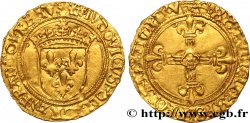Live auction - fme_930848 - SECOND EMPIRE Médaille, Hommage de la Ville de Paris à l'empereur Napoléon Ier, refrappe
You must signin and be an approved bidder to bid, LOGIN TO BID. Accounts are subject to approval and the approval process takes place within 48 hours. Do not wait until the day a sale closes to register. Clicking on "BID" constitutes acceptance of the terms of use of cgb.fr private live auctions.
Bids must be placed in whole Euro amounts only. The sale will start closing at the time stated on the item description; any bids received at the site after the closing time will not be executed. Transmission times may vary and bids could be rejected if you wait until the last second. For further information check the Live auction FAQ
All winning bids are subject to a 18% buyer’s fee.
All winning bids are subject to a 18% buyer’s fee.
| Estimate : | 180 € |
| Price : | 115 € |
| Maximum bid : | 130 € |
| End of the sale : | 17 December 2024 14:49:22 |
| bidders : | 4 bidders |
Type : Médaille, Hommage de la Ville de Paris à l'empereur Napoléon Ier, refrappe
Date: (1854)
Mint name / Town : 75 - Paris
Metal : bronze
Diameter : 77 mm
Orientation dies : 12 h.
Engraver OUDINÉ Eugène-André (1810-1887)
Weight : 200,77 g.
Edge : lisse + corne BRONZE
Puncheon : corne BRONZE
Coments on the condition:
Patine hétérogène avec des taches d’oxydation. Présence de traces d’usure, quelques coups et rayures
Catalogue references :
Obverse
Obverse legend : IN NEPOTE REDIVIVUS.
Obverse description : Devant un temple, apothéose de Napoléon 1er sur un quadrige montant vers le ciel, précédé de l'aigle impérial tenant la foudre entre ses serres, couronné par l'Immortalité et guidé par la Renommée tenant une palme dans chaque main ; au bas, de gauche à droite : la France levant les bras au ciel, le rocher de l'île de Sainte-Hélène, le Désordre poursuivi par la Justice surgissant de derrière un autel. Signé : E.A. OUDINE / INGRES PINXIT. Poinçon visible à 11 heures : C/B-A.
Obverse translation : Renaissant en son neveu.
Reverse
Reverse legend : (FLEUR) A. L’EMPEREUR. NAPOLEON. PREMIER. LA. VILLE. DE. PARIS. (FLEUR) - MDCCCLIV À L’EXERGUE FLUCTUAT NEC MERGITUR.
Reverse description : Les armes de la ville de Paris supportées par des allégories ailées, surmontant la devise. Signé : E.A. OUDINÉ F. Poinçon visible à 12 heures : C/B-A.
Commentary
Médaille conservée dans une boîte bleue.
La médaille fait également partie des collections du Musée du Louvre : https://collections.louvre.fr/ark:/53355/cl010465369.
Visibilité d’un poinçon B.A sur les deux faces de la médaille.
La médaille fait également partie des collections du Musée du Louvre : https://collections.louvre.fr/ark:/53355/cl010465369.
Visibilité d’un poinçon B.A sur les deux faces de la médaille.








 Report a mistake
Report a mistake Print the page
Print the page Share my selection
Share my selection Ask a question
Ask a question Consign / sell
Consign / sell
 Full data
Full data















